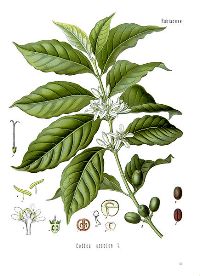Go Green!
 Coffea arabica is an autotrophic plant
meaning it uses photosynthesis to make its own food, meanwhile
producing large amounts of oxygen as a byproduct. A coffee
field has the ability to produce half the amount of oxygen the
rainforest does occupying the same amount of area!
Coffea arabica is an autotrophic plant
meaning it uses photosynthesis to make its own food, meanwhile
producing large amounts of oxygen as a byproduct. A coffee
field has the ability to produce half the amount of oxygen the
rainforest does occupying the same amount of area!
How it works; the plant, in presence of light, uses
both carbon dioxide and water to produce glucose, oxygen, and a
smaller amount of water. The light energy from the
chlorophyll in the chloroplasts is stored in the form of ATP
(adenosine triphosphate) and used for aerobic respiration.
The ATP is then used in the Calvin cycle to convert CO2
to sugar. These sugars are used to support the rest of the
plant.
6CO2
+ 12H2O + Light energy
→ C6H12O6
+ 6O2 + 6H2O
Sugar, water, carbon dioxide, and other nutrients
the plant needs dispersed throughout its structure, are spread
via vascular tissue, xylem and phloem. Tubes of xylem absorb
water and nutrients from the roots, while carbon dioxide enters
the leaves of the plant via the opening and closing of
specialized cells called stomata. The water absorbed is
typically pulled up from the roots to supply the rest of the
plant due to adhesion, cohesion, and capillary action. Phloem is
arranged tubes running around the outer part of the plant but
under the bark containing sieve tube members, companion cells,
and parenchyma cells that transport the sugars and other organic
molecules produced in the leaves typically down to the other
parts of the plant.
Luckily the coffee “shrubs” are trimmed down to be about the
size of a man for the purposes of harvesting otherwise coffee
trees can grown around 25-35 feet in height, nothing compared to
trees that are hundreds of feet tall and still have to get water
all the way to the top! Coffee trees grown for production are
kept at short stature and not allowed their full height; however
they still manage to produce around 2 lbs of coffee a year
making about 200 cups of brew. (Click here to see how
coffee is made!)
The coffee seeds are planted in the soil either on small family
farms up to large coffee plantations (Visit the Bean Belt to see
where coffee is grown). 3-4 years after the seeds are planted
and the roots have taken hold, the flowers are capable of
blooming depending on climate and pollination. The roots dig
deep into the soil; the main taproot can be 30-45 cm deep while
other parts of the root grow horizontally reaching out meters in
length. The leaves are the major source of oxygen from the plant
and are of a dark, shiny green color, with a very waxy
appearance. About 6-8 months after being pollinated, either by
wind mediated pollination or by insects especially bees (To see
more on bee pollination), the berries will be ready to be
harvested. They have matured from an original dark green color
to yellow then a dark crimson red which is why they are called
“cherries” by farmers and harvesters. The cherries are typically
.5 to ¾ in. long when they are either hand picked of shaken off
onto mats, collected, and put through to the production process.
